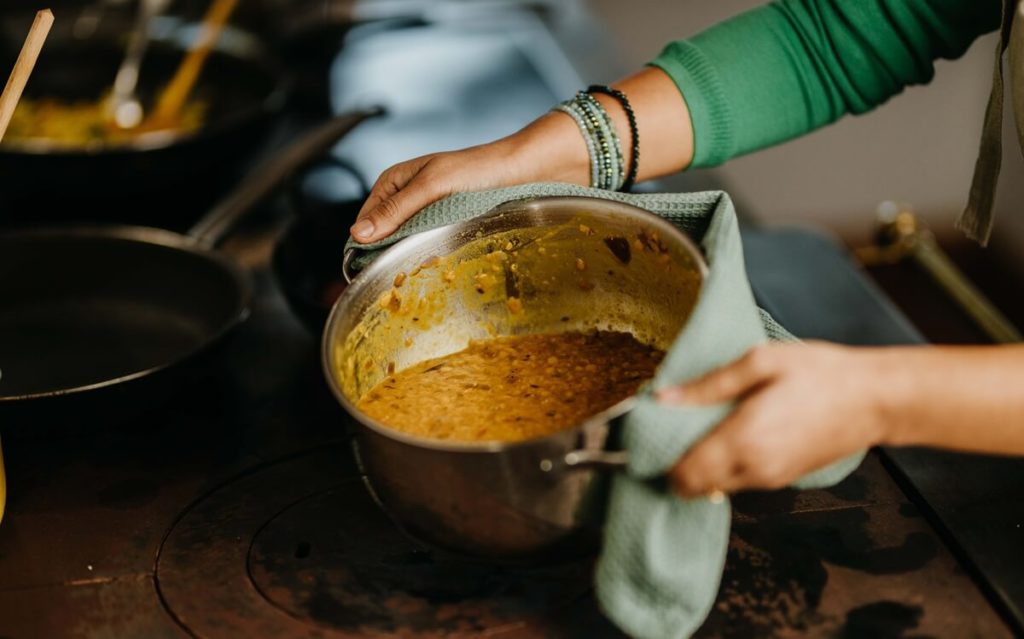An unhealthy lifestyle and the resulting excess weight are among the main factors behind health problems. Many diets only have a temporary effect and long-term results are difficult to achieve. With Ayurveda you can lose weight sustainably and healthily.
Obesity from an Ayurvedic perspective
In Ayurveda, the causes of obesity are considered for each person as an individual. Disorders of the digestive and energy tract can be just as much a reason as a disturbed process of tissue formation. The decisive factor here is a weakening of the body's fire Jathar-Agni, which can lead to an increase in fatty tissue.
An Ayurvedic diet is not a classic diet, but takes the entire lifestyle into consideration. From an Ayurvedic point of view, it is basically about maintaining the natural balance of the three doshas Vata, Pitta and Kapha. This forms the basis for your health and well-being. If your doshas are out of balance, this often results in unhealthy eating habits. It is therefore important to first determine your dosha type.


In Ayurveda, obesity is a Kapha disorder. Kapha represents the preserving and stabilizing principle within the human organism. It carries the function of the lymphatic and immune system and participates in the formation of the body via the skeleton and cell structure.
Losing weight according to constitutional types
As a Vata type it is important to pay attention to calming the restless, dry and cold air element in your diet. You can achieve this with warm, oily foods such as nutritious stews, casseroles and soups. Rice and warm milk are also good for you.
As a fiery Pitta type you should pay attention to a bitter taste and integrate green leafy vegetables into your diet. Cucumbers, green salad, mushrooms, chicory, peppers, zucchinis, apples, pineapple, sweet cherries, raisins, barley, oats and rice, milk or nuts are just right for you.
To lose weight as a Kapha type, you should above all avoid heavy, fatty and cold foods. Also, don't eat more than you are hungry for, but consciously curb your appetite, as this type tends to be the most overweight. Low-fat foods, fresh fruit, salads and vegetables should be an integral part of your diet.
Causes of obesity in Ayurveda
The following causes are among the most common reasons for obesity in the Ayurvedic diet. With the right diet and lifestyle, many of these factors can be sustainably regulated.
- Excessive consumption of fatty, fried foods, cheese, yogurt and ice cream, as well as sugary foods and cold drinks
- Prolonged sitting, inactive lifestyle
- Digestive disorders
- Frequent eating between meals
- Stress
- Taking medication such as corticosteroids or oral contraceptives and insulin
- High alcohol consumption
- Unresolved conflicts - supposed solution through food (food for the soul)
- Hormonal dysregulation, excessive production of growth hormones
Learn to listen to your body
As a child, your parents showed you what makes you feel good and what is right for you and your well-being. The older you get, the more external influences affect you and shape your eating habits. A typical consequence of this is that you crave a certain food without knowing exactly what it is.
You probably know when you are "hungry" and eat something from the fridge but can't really satisfy your craving. From an Ayurvedic perspective, it is important to pause for a moment at such times. Try to consciously listen to yourself and find out what your body is craving.
Before you simply eat anything, it helps to drink a balancing warm drink first, for example a sip of warm water. You will be amazed at how well your body communicates with you. Instead of the original feeling of hunger, for example, you might feel the need to go for a walk.
Wanting to compensate for everything with food is a side effect of people not listening to themselves enough and allowing themselves to be influenced too much from the outside. This makes it all the more important that you learn to listen to yourself and your body again.
Lose weight sustainably with European Ayurveda
The aim of European Ayurveda® is an alternative healing approach that helps you to lose body weight in a gentle and healthy way. According to Ayurveda, weight problems are not always automatically linked to a poor diet. Often the origin is also a reduced function of your metabolism due to slagging.


#1: Change eating habits in small steps
The best way for your body to adopt a new routine is to slowly get used to it. Start with small changes in your daily routine, such as eating regularly or having your main meal at lunchtime. Eat with pleasure and avoid stress during meals.
Here, too, it is important to know your Dosha type. Based on this, you can now create an individual nutrition plan that is tailored to you and your needs.
In a further step, you can make sure to integrate all six flavors (sweet, sour, spicy, salty, bitter and tart) into your meals. Ayurveda emphasizes the health-promoting effect of taste. A good start is to incorporate all tastes into different meals throughout the day.
#2: Ayurvedic nutrition
Determining your constitutional types is essential for sustainable and long-term weight loss with Ayurveda. Only if you know exactly how the doshas are distributed can you adjust your Ayurvedic diet accordingly. In addition to a Dosha test, an Ayurveda expert at our resort can also help you determine this.
Together you will find out where there is an imbalance and what is best to do about it. Depending on whether there is too much Vata, Pitta or Kapha, an individual nutrition plan with a food table is put together. This includes foods that balance your doshas and help you make a long-term change to your diet.
In general, an Ayurvedic diet contains little meat, fish and eggs. Instead, vegetables, dairy products and healthy oils are preferred.
#3: Get your metabolism going
A stimulated metabolism is important to prevent slagging and keep your immune system going. To do this, drink hot water that has been boiled for 10 minutes throughout the day. If you start to feel hungry, drink a few sips every five minutes. At the same time, consciously pay attention to what your body actually needs.
Regular physical activity also benefits your metabolism. An exercise session in the morning between 6 and 10 a.m. is best.


An Ayurvedic massage, such as the dry rubbing massage Garshan , has an additional supportive effect and can be performed daily on the whole body. The Ayurvedic Panchakarma cure is also ideal for deep cleansing at all levels. With our book, you can also carry out a Panchakarma treatment at home!


Ayurveda Panchakarma cure for at home
In our book "Ayurveda: The 7-day Panchakarma cure for at home", our experts show you how you can gently detoxify in 7 days.
#4: Lose weight with Ayurvedic medicinal plants
To support the weight loss process, there are a number of Ayurvedic medicinal plants and spices that can be taken in the form of teas or capsules.


Ginger and the medicinal plant ashwagandha influence the regulation of your hormone balance. The latter is characterized by its anti-inflammatory effect and the reduction of the cortisol balance if stress is the cause of your excess weight.
#5: Ayurvedic treatments for weight loss
With the right Ayurvedic treatment, you can help your body to purify and regeneration. This gives it the opportunity to produce new energy and balance your doshas. The detoxification and loosening of toxins through sweating also helps you to lose weight.
There are special Ayurvedic massage techniques for firming your tissue and reducing your weight. Kapha is reduced and specific regions of your body and tissue undergo deep detoxification. In addition to proper nutrition, the metabolism of the tissue is stimulated and supported in the detoxification and firming process.
Ayurvedic recipes for losing weight
There are numerous Ayurvedic recipes for losing weight. It is important that you take your constitutional type into account when choosing your diet. Together with an Ayurveda expert, you can create a diet plan that suits you and your individual needs.


The following two recipes can help you lose weight. They are suitable for both lunch and dinner and provide lasting satiety.
Beluga lentils with spinach
| Ingredients (for 2 people) | Preparation |
| - 500 g fresh spinach - 1 tsp green masalum - 1 tbsp original Ayurveda ghee - 1 small onion, finely diced - 50 g beluga lentils - 1/2 green chili pepper, cut into fine rings - 300 ml water - 1 red bell pepper, finely diced or in strips - salt Ingredients for green masalum - 50 g coconut powder (from an Asian or organic store) - 1 handful of fresh herbs, chopped - 1 tsp herbes de Provence - 1 tsp fresh ginger, grated - 1 fresh green chilli - 1 tsp fenugreek leaves (from an Asian or organic store) - 3 tsp lemon juice - 2 tsp brown sugar - 1 tsp salt - 125 ml rapeseed oil Ingredients for ghee - 250 g organic butter | - For the ghee, bring 250 grams of organic butter to the boil in a pan. - Reduce the heat as soon as the butter foams and bubbles. - Leave the mixture to simmer for about 15 minutes until a brown sediment forms and all the liquid has evaporated. - Filter the ghee through a metal sieve lined with kitchen paper. - Once cooled, store the ghee in a dark, cool place. Alternatively, you can buy ghee in our online store. - For the masalum, stir all the ingredients until smooth or blend them with a stick. - Wash the spinach and bring to the boil with a very small amount of water for five minutes. - Add the masalum and blend until smooth. Set aside. - Heat the ghee and sauté the onion in it for one minute. - Add the lentils and chili and deglaze with water. - Cook everything over a medium heat for 20 to 25 minutes until the lentils are cooked. Add water if necessary. - Add the spinach and bring everything to the boil again. - Season with salt and garnish with paprika. |
Quinoa veggie burger
| Ingredients (for 2 people) | Preparation |
| - 100 g quinoa - 250 g mixed seasonal vegetables - 1 tbsp chickpea flour or potato flour - 2 tsp yellow masalum - 2 tsp fresh herbs, finely chopped - salt Ingredients for the yellow masalum - 50 g coconut powder (from an Asian or organic store) - 2 tsp turmeric - 1 fresh red chilli pepper - 2 tsp lemon juice - 2 tsp brown sugar - 1/4 tsp ginger, ground - 1/4 tsp cinnamon, ground - 1 tsp salt - 100 ml rapeseed oil | - For the masalum, stir all the ingredients until smooth or blend them with a stick. - Prepare the quinoa according to the pack instructions. - Peel, clean and finely dice the vegetables as required. - Cook in a little water and drain. - Preheat the oven to 200 degrees (fan oven). - Mix the quinoa with the vegetables and the remaining ingredients and season with salt. Then shape the mixture into burgers. - Place on a baking tray lined with baking paper and bake in the oven for eight to ten minutes. - Assemble everything and enjoy. |


Ayurveda cookbook for at home
Discover the cookbook "Es geht mir richtig gut mit Ayurveda" for at home - with 60 simple and healthy recipes from the European Ayurveda Resort Sonnhof!
Conclusion: Lose weight with European Ayurveda®
In European Ayurveda®, each person's individual constitution and dosha type are taken into account when losing weight. Based on this, it offers a holistic approach consisting of Ayurvedic nutrition, which stimulates the metabolism, as well as Ayurvedic medicinal plants and treatments.
The most important thing is to change your lifestyle habits step by step. This is how to achieve sustainable results and positive Ayurveda weight loss experiences. Going without is not the first priority and the delicious recipes make losing weight really fun!


Ayurveda colon cleansing and intestinal detoxification
By cleansing your intestines, you can completely eliminate harmful bacteria and alleviate discomfort. You can find out how Ayurvedic colon cleansing works and how you can do it at home here.




